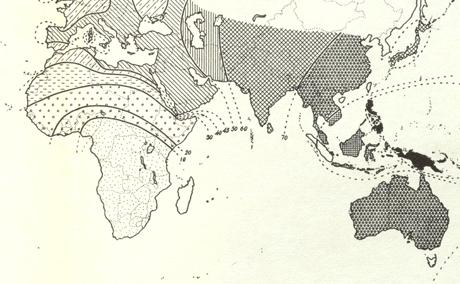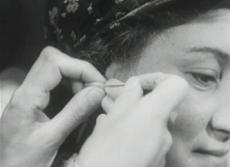Today, physicians use genetic variation to help predict responses to drugs, forensic scientists construct facial morphologies from traces of blood, and private companies offer genetic ancestry tests in exchange for a cheek swab. Many of the questions and techniques of contemporary human genetics were first established between 1920 and 1960, when the only human characters with clear-cut “Mendelian” inheritance were blood groups. The current project looks back at those decades to show how the practices and institutions for blood-group research established human genetics as the preeminent field for addressing questions of race, geographic ancestry and disease inheritance (Figure 1).

Figure 1: Map from Arthur Mourant’s The Distribution of the Human Blood Groups (Oxford: Blackwell Scientific Publications, 1954). The map shows the percentage of individuals carrying a particular blood-group allele in different regions of the world. Mourant’s intention was to offer a narrative about the migrationary history of human populations. For him, blood-group genetic variation offered “objective criteria” for studying human diversity that were “far removed from the traditional marks of ‘race’.”
This is partly a story about the recruitment of people into modern administrative institutions for public health—in particular the blood transfusion services. In Britain, the first nationwide transfusion service was established on the eve of the Second World War. It consisted of a network of blood depots that tested large numbers of volunteers and organised the extraction, preservation and mobilization of blood (Figure 2). At the centre of this network was a laboratory called the Galton Serum Unit, whose workers carried out practical tasks for the depots, and in exchange acquired specimens and donor records for genetic research. These exchange practices were sustained and expanded after the war ended, when two new labs were established at the Lister Institute in London, run by former Galton Serum Unit members Arthur Mourant and Robert Race. Their labs became international centres of blood-grouping expertise, as they were co-opted by the newly established World Health Organization (WHO) to distribute standardized grouping reagents around the world. Just as during the war, Mourant and Race acquired blood samples and grouping results from transfusion specialists, doctors, missionaries, geneticists and anthropologists. They used these to study the genetic inheritance of new blood groups, to follow the segregation of complex disease traits, and to map the geography of genetic diversity. In short, the recruitment of people into large-scale administrative technologies for public health made it possible to articulate a kind of human genetics that relied on the statistical analysis of large quantities of data. This story is part of a bigger argument about a postwar amplification in the study and management of human populations. “Population studies” linked human heredity research to the broader politics of the postwar world, conditioned by Cold War tensions and by a new internationalism. This is the topic of a forthcoming special issue, Heredity and the study of human populations after 1945, edited by Jenny Bangham and Soraya de Chadarevian.

Figure 2: Making inscriptions from blood grouping tests on a porcelain tile; a still image from the film Blood Grouping, Cyril Jenkins Productions Ltd (Imperial Chemical Industries Limited, 1955), Wellcome Library.
In addition, the project explores how blood groups were made to serve in overlapping disciplinary, national and international political agendas. During the early 1930s blood groups were promoted as traits that offered the route to an unbiased understanding of human inheritance, and the most promising refutation of notions of race purity. After the war, this rhetoric was restated on a more international stage during UNESCO’s campaign to undermine racial prejudices through the dissemination of “scientific facts.” The picture at the top of the page comes from the UNESCO picturebook What is Race? (1952) which was designed to present “in a popular way,” the notion that genetics can produce neutral, scientific and universal knowledge about race and ancestry, an idea that is still persuasive today.

Figure 3: Blood donor having her ear lobe pricked for a blood-grouping test. This still comes from the wartime public information film Blood Transfusion Service, directed and edited by H.M. Nieter (Ministry of Health, in cooperation with the MRC and the Blood Transfusion Units of the Fighting Services, 1941).
Along the way, the project traces the labour of collecting: from decisions about which populations to study, to choices about whose bodies to sample, to the exchanges through which blood and blood groups were made into laboratory resources (Figure 3). The project also follows the “paper work” through which blood groups were made into material objects, organised and ordered, and transformed into credible genetic data. These practices of collection, inscription and analysis were shaped by historical narratives, notions of racial and national identity, and institutions for public health. Together they made blood groups into pre-eminent objects of genetic research and powerful markers of biological difference.
